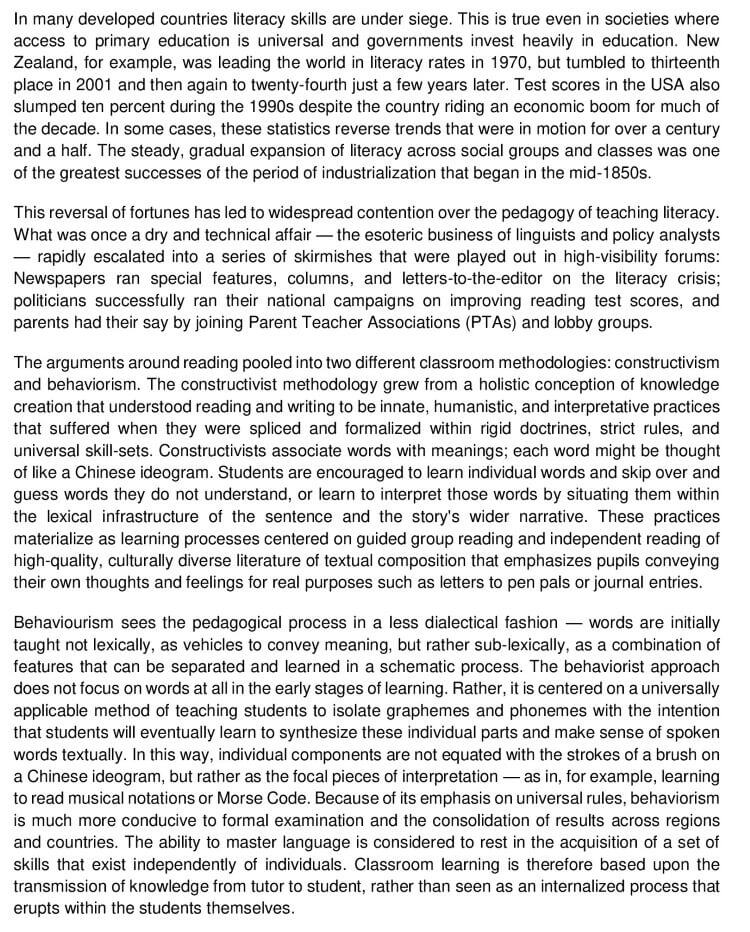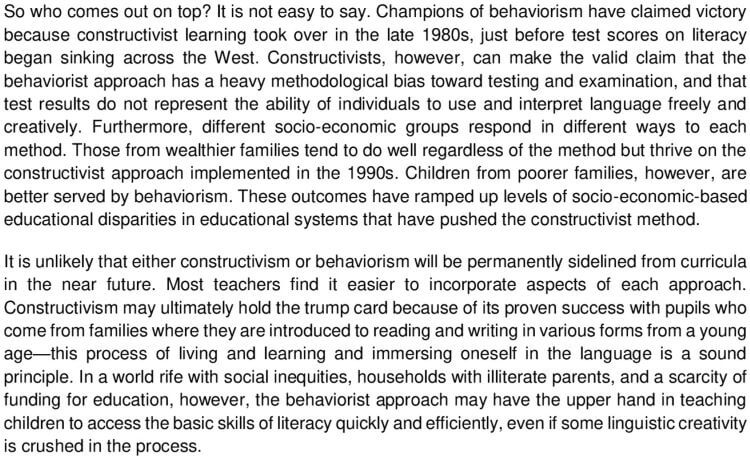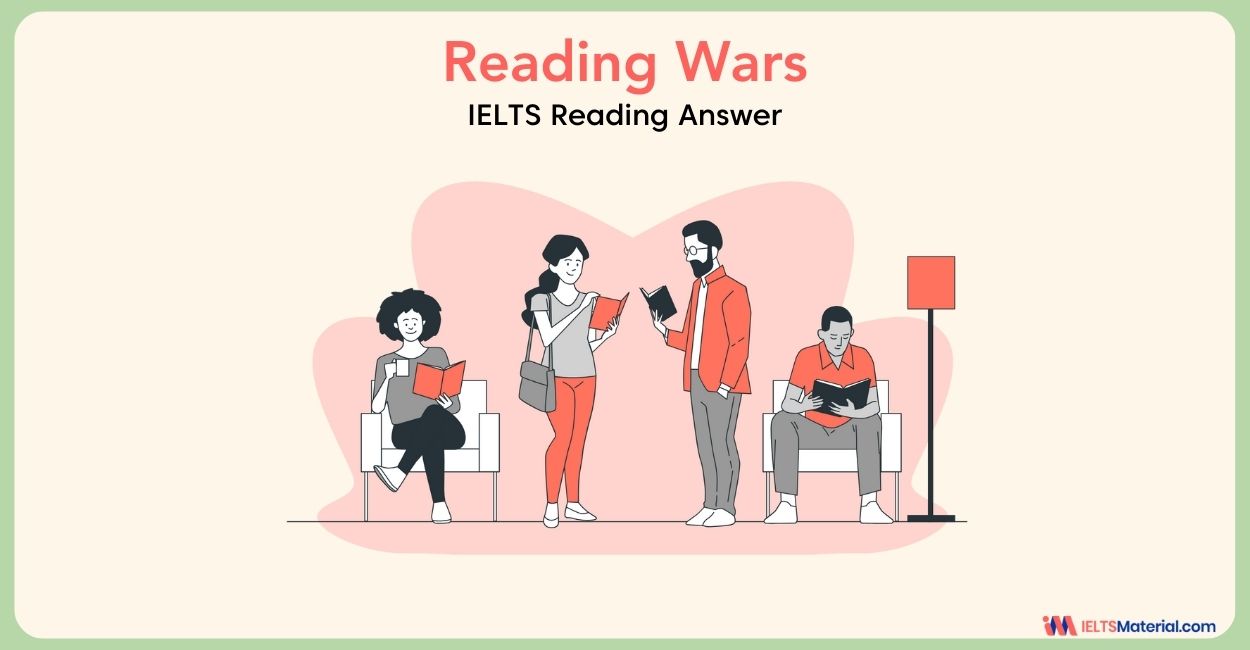Reading Wars IELTS Reading Answer
11 min read
Updated On
-
Copy link
Look into the IELTS Reading 'Reading Wars' IELTS Reading Answer' Practice Test with the answer key and upgrade your reading skills.
Table of Contents

Limited-Time Offer : Access a FREE 10-Day IELTS Study Plan!
Various question types are asked in IELTS Academic Reading to test specific reading skills and some of them are given in Reading Wars IELTS Reading Answers. Some of these question types are:
- Matching Information IELTS Reading (Q. 27-33)
- IELTS Reading Multiple Choice Questions (Q. 34-40)
Ideally, IELTS test-takers should take around 20 minutes to solve a passage like ‘Reading Wars’ in IELTS Reading. Therefore, to master this skill, they need to take IELTS reading practice tests regularly. Let’s see how easy this passage is for you and if you’re able to make it in 20 minutes.
Reading Passage
Reading Wars


Questions 27-33
Reading Passage 3 has six paragraphs, A—F.
Which paragraph contains the following information?
Write the correct letter, A-F, in boxes 27-33 on your answer sheet.
NB You may use any letter more than once.
27 A reason why constructivism might increase inequalities in society
28 Ways in which people debated the merits of different ways of teaching reading
29 A comparison between forms of communication that build meaning from isolated parts
30 Reasons why a method that is theoretically superior might not always work effectively in practice
31 An explanation of why measuring the success of different reading methods is difficult
32 An example of an activity that teachers might use to develop writing skills
33 Evidence of a national decline in reading standards
Question 34-36
Choose THREE letters, A-G.
Which THREE of the following are features of constructivism?
A Students learn best by working on their own.
B People are naturally inclined to develop language abilities.
C It is vital that a disciplined and regulated approach is used.
D It is important that students understand every word they encounter.
E Language is best learned as a single, organic process.
F Everyone learns to read and write in a similar manner.
G Context can provide helpful cues to understanding words.
Question 37-39
Choose THREE letters A-G.
Write your answers in boxes 37-39 on your answer sheet.
Which THREE of the following are features of behaviorism?
A The whole of a word is less important than its parts.
B There is not a common set of conventions.
C Students learn best by worl0ng on their own.
D Meaning is created by connecting word fragments.
E Linguistic capacities are built into people.
F Students learn by receiving information from teachers.
G It is difficult to judge how well students are doing collectively.
Question 40
Choose the correct letter, A, B, C, or D.
Write your answer in box 40 on your answer sheet.
Which of the following statements best summarises the writer’s general conclusion?
A Constructivism is better, while behaviorism leads to negative social effects.
B Each method complements the other, and their application should be integrated.
C Ideally constructivism would be used, but behaviorism is more pragmatic.
D Neither is particularly useful, and there needs to be a new alternative.
Answers of Reading Wars Reading Answers With Location and Explanations
Go through the answers and detailed explanations of each question in the Reading Wars passage and prepare to get a high IELTS Reading band score.
27 Answer: E
Question type: Matching Information
Answer location: Paragraph E
Answer explanation: Paragraph E states the fact, “Constructivists, however, can make the valid claim that the behaviorist approach has a heavy methodological bias towards testing and examination, and that test results do not represent the ability of individuals to use and interpret language freely and creatively. Furthermore, different socio-economic groups respond in different ways to each method. Those from wealthier families tend to do well regardless of the method but thrive on the constructivist approach implemented in the 1990s. Children from poorer families, however, are better served by behaviorism. These outcomes have ramped up levels of socio-economic-based educational disparities in educational systems that have pushed the constructivist method.” These lines illustrate a reason why constructivism might increase inequalities in society. Thus, the answer is paragraph E.
28 Answer: B
Question type: Matching Information
Answer location: Paragraph B
Answer explanation: Paragraph B states, “This reversal of fortunes has led to widespread contention over the pedagogy of teaching literacy. What was once a dry and technical affair — the esoteric business of linguists and policy analysts — rapidly escalated into a series of skirmishes that were played out in high-visibility forums” We can deduce from these lines that the reversal of fortunes resulted in the widespread contention over the pedagogy of teaching literacy. It was a dry and technical affair. The esoteric business of linguists and analysts got into an episode of fights that were played out in high visibility forums. Thus, these lines indicate ways in which people debated the merits of different ways of teaching reading. Hence, the answer is B.
29 Answer: D
Question type: Matching Information
Answer location: Paragraph D
Answer explanation: Paragraph D states, “Behaviourism sees the pedagogical process in a less dialectical fashion — words are initially taught not lexically, as vehicles to convey meaning, but rather sub-lexically, as a combination of features that can be separated and learned in a schematic process. The behaviorist approach does not focus on words at all in the early stages of learning. Rather, it is centered on a universally applicable method of teaching students to isolate graphemes and phonemes with the intention that students will eventually learn to synthesize these individual parts and make sense of spoken words textually.” These lines suggest a comparison between the forms of communication that build meaning from isolated parts. Hence, the answer is D.
30 Answer: F
Question type: Matching Information
Answer location: Paragraph F
Answer explanation: Paragraph F illustrates that It is unlikely that either constructivism or behaviorism will be permanently sidelined from curricula in the near future. Most teachers find it easier to incorporate aspects of each approach. Constructivism may ultimately hold the trump card because of its proven success with pupils who come from families where they are introduced to reading and writing in various forms from a young age—this process of living and learning and immersing oneself in the language is a sound principle. In a world rife with social inequities, households with illiterate parents, and a scarcity of funding for education, however, the behaviorist approach may have the upper hand in teaching children to access the basic skills of literacy quickly and efficiently, even if some linguistic creativity is crushed in the process. These lines indicate reasons why a method that is theoretically superior might not always work effectively in practice. Hence, the answer is F.
31 Answer: E
Question type: Matching Information
Answer location: Paragraph E
Answer explanation: The introductory line of paragraph E states, “So who comes out on top? It is not easy to say. Champions of behaviorism have claimed victory because constructivist learning took over in the late 1980s, just before test scores on literacy began sinking across the West. Constructivists, however, can make the valid claim that the behaviorist approach has a heavy methodological bias towards testing and examination, and that test results do not represent the ability of individuals to use and interpret language freely and creatively.” These lines reveal an explanation of why measuring the success of different reading methods is difficult. Hence, the answer is E.
32 Answer: C
Question type: Matching Information
Answer location: Paragraph C, line 7
Answer explanation: The 7th line of paragraph C states that students are encouraged to learn individual words and skip over and guess words they do not understand or learn to interpret those words by situating them within the lexical infrastructure of the sentence and the story’s wider narrative. These practices materialize as learning processes centered on guided group reading and independent reading of high-quality, culturally diverse literature of textual composition that emphasizes pupils conveying their own thoughts and feelings for real purposes such as letters to pen pals or journal entries. These lines suggest an example of an activity that the teachers might use to develop the writing skills of the students. Hence, the answer is C.
33 Answer: A
Question type: Matching Information
Answer location: Paragraph A
Answer explanation: Paragraph A states that in many developed countries literacy skills are under siege. This is true even in societies where access to primary education is universal and governments invest heavily in education. New Zealand, for example, was leading the world in literacy rates in 1970, but tumbled to thirteenth place in 2001 and then again to twenty-fourth just a few years later. Test scores in the USA also slumped ten percent during the 1990s despite the country riding an economic boom for much of the decade. These lines suggest evidence of a national decline in reading standards. Hence, the answer is A.
34 Answer: B
Question type: Multiple Choice Question
Answer location: Paragraph D, 2nd last line
Answer explanation: The 2nd last line of paragraph D states that the ability to master language is considered to rest in the acquisition of a set of skills that exist independently of individuals. These lines indicate that mastering language skills is considered to rest in the acquisition of certain skills that exist independently of individuals. Thus, one of the features of constructivism is that people are naturally inclined toward developing their language skills. Hence, the answer is B.
35 Answer: E
Question type: Multiple Choice Question
Answer location: Paragraph F, line 3
Answer explanation: The 3rd line of paragraph F states that Constructivism may ultimately hold the trump card because of its proven success with pupils who come from families where they are introduced to reading and writing in various forms from a young age—this process of living and learning and immersing oneself in the language is a sound principle. These lines illustrate that language is best learned as a single, organic process. process. So, the answer is E.
36 Answer: G
Question type: Multiple Choice Question
Answer location: Paragraph C, line 5
Answer explanation: The 5th line of paragraph C states that constructivists associate words with meanings; each word might be thought of like a Chinese ideogram. Students are encouraged to learn individual words and skip over and guess words they do not understand, or learn to interpret those words by situating them within the lexical infrastructure of the sentence and the story’s wider narrative. We can deduce from these lines that context can provide helpful cues to understanding words. Hence, the answer is G.
37 Answer: A
Question type: Multiple Choice Question
Answer location: Paragraph D, line 3
Answer explanation: The 3rd line of paragraph D states that the behaviorist approach does not focus on words at all in the early stages of learning. These lines indicate that the whole of a word is less important than its parts. Thus, the answer is A.
38 Answer: D
Question type: Multiple Choice Question
Answer location: Paragraph D
Answer explanation: The introductory lines of paragraph D state that Behaviourism sees the pedagogical process in a less dialectical fashion — words are initially taught not lexically, as vehicles to convey meaning, but rather sub-lexically, as a combination of features that can be separated and learned in a schematic process. These lines illustrate that meaning is created by connecting word fragments. Hence, the answer is D.
39 Answer: F
Question type: Multiple Choice Question
Answer location: Paragraph D, last line
Answer explanation: The last line of paragraph D illustrates that Classroom learning is therefore based upon the transmission of knowledge from tutor to student, rather than seen as an internalized process that erupts within the students themselves. We can understand from these lines that students learn by receiving information from teachers in the classroom. Hence, the answer is F.
40 Answer: C
Question type: Multiple Choice Question
Answer location: Paragraphs A – F
Answer explanation: When we go through paragraphs A – to, we understand that the writer’s general conclusion to the reading passage is that ideally constructivism would be used, but behaviorism is more pragmatic. Thus, the suitable conclusion to the passage and the answer is C.
Tips to Solve the Question Types in Reading Books IELTS Reading Answers
Now that you have the answers and explanations for Reading Books Reading Answers, let’s explore some IELTS exam preparation tips for answering the four question types.
Matching Headings:
You must match the heading in this type of question to the appropriate paragraph or reading segment in the text. Your ability to figure out the paragraph’s key concept and its supporting ideas will be put to the test and help you score a high IELTS band score.
- Take your time to rephrase the potential headings’ keywords.
- Find the main idea by scanning and skimming the paragraphs. Sometimes the essential idea of the paragraph is expressed in the header.
- For clarification on the paragraph’s main idea, see the first and last sentences. Likewise, quickly scan the middle of the paragraph to make sure you comprehend it.
- Don’t try to match words. Your primary goal is to match a correct paragraph.
- Choose the heading that best fits the paragraph after reading it again if two seem to be appropriate.
- The number of headings will always be greater than the number of paragraphs or sections. Therefore, some headings will never be utilized.
Multiple-Choice Questions:
You will be given a reading passage followed by several questions based on the information in the paragraph in multiple-choice questions. Your task is to understand the question and compare it to the paragraph in order to select the best solution from the available possibilities.
- Before reading the passage, read the question and select the keywords using IELTS Reading keyword techniques. Check the keyword possibilities if the question statement is short on information.
- Then, using the keywords, read the passage to find the relevant information.
- To select the correct option, carefully read the relevant words and match them with each option.
- You will find several options with keywords that do not correspond to the information.
- Try opting for the elimination method and find the best option by matching the meaning rather than just the keywords.
Check More IELTS Reading Answers
Practice IELTS Reading based on question types

Start Preparing for IELTS: Get Your 10-Day Study Plan Today!
Recent Articles

Nehasri Ravishenbagam

Haniya Yashfeen

Haniya Yashfeen

Haniya Yashfeen




Post your Comments